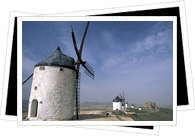 Castilla la Mancha
Castilla la Mancha
If you're a literature buff anxious to channel your inner Don Quijote or a history lover looking to explore on of Spain's most historically prominant regions, Castilla la Mancha is the place for you. Here, Miguel de Cervantes Saavedra's unforgettable literary icon valiently battled windmills and traversed the parched lands of Spain's interior plateau in a quest to save his beloved Dulcinea del Toboso
Castilla la Mancha bears endless vestiges of its past. Set in a landscape of olive groves and sun-baked land, Roman ruins rub shoulders with medieval fortresses, traditional towns and emblematic cities like Toledo and Cuenca. Judging by parched landscape of La Mancha - which is commonly thought to derive from the Arabic "ma-ansha," meaning "no water" - it's not hard to figure out that summers here are pretty toasty. However, Castilla la Mancha's scenic mountain ranges provide the perfect refuge from the searing summer sun.
 Extremadura
Extremadura
Extremadura is an interesting case in that it remains far off the proverbial tourist trail, yet serves as a microcosm of everything that makes Spain so fascinating. The extremely diverse region boasts sweeping hills and valleys, wooded sierras, endless rivers and creeks, jaw-dropping gorges and pastures stretching as far as the eye can see. It's the perfect opportunity to step off the beaten trail, distance yoursel from Spain's more tourist-laden towns and discover a beautiful, diverse and interesting region of Spian.
Tucked into valleys, perched upon mountain tops and dotting the countryside are old, picturesque towns and villages still soaking in an unmistakably medieval atmosphere. Church towers and castles stand out in the quaint towns in living photographs of the past. Plus, the region has one particular claim to fame: ham. The mountainous stretches around Extremadura's fringes yield the famous "jamón de bellota," a cured ham made from pigs on an acorn-only diet.